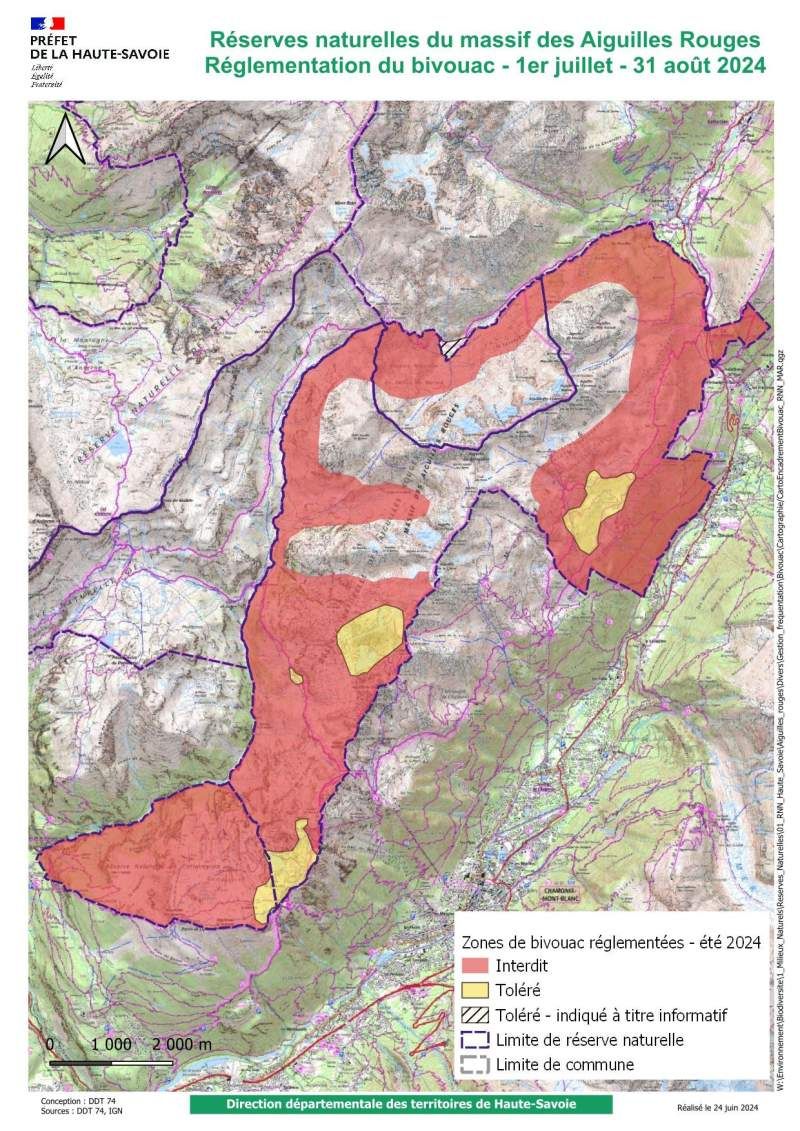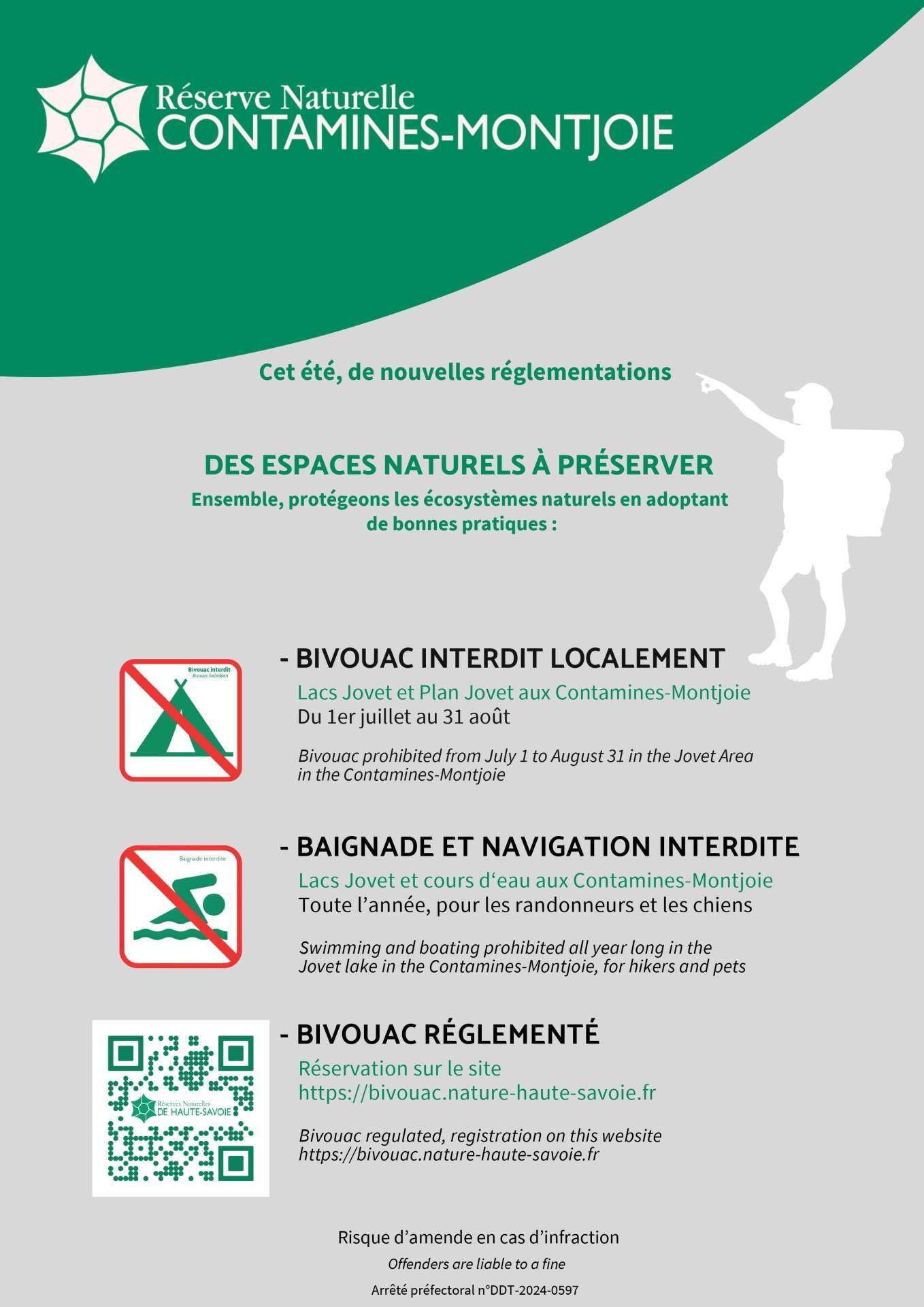Bivouac and Wild Camping
A bivouac refers to a temporary camp, which may be under the stars or in a light tent, set up from sunset to sunrise, for one single night in the same spot. The principle is to spend the night without leaving any trace or making a fire.
In contrast, wild camping refers to camping outside designated areas, usually for several days in the same location.
ITALY – Aosta Valley
All forms of parking or camping are prohibited throughout the Aosta Valley, even for stays of less than 24 hours.
Bivouacs are forbidden below 2,500 m, which applies to nearly the entire section of the Tour du Mont-Blanc crossing this region.
SWITZERLAND – Valais
Bivouacs and wild camping** are generally prohibited in Switzerland**.
Exceptions: spending one night only, not in a group, and above the tree line, or in cases of emergency.
Bivouacs are also prohibited within certain protected areas (nature reserves, wildlife protection zones, quiet zones, some park areas, etc.), in hazardous zones, and along forest roads.
For the Valais municipalities along the Tour du Mont-Blanc, the following rules apply :
- Bovernier: Wild camping is prohibited, and there are no official campsites in the municipality.
- Martigny-Combe: Wild camping is prohibited, and there are no official campsites in the municipality.
- Orsières: Camping is only permitted in designated areas (Camping de la Fouly, Camping du Relais d’Arpette). Wild camping is tolerated according to the exceptions mentioned above.
- Trient: Wild camping is prohibited. Camping is possible at the rest areas of Le Peuty and Le Stand, as well as at Camping de l’Arpille (Col de la Forclaz).
FRANCE
Chamonix
In the municipality of Chamonix, both camping and bivouacs have been prohibited throughout the territory since 1992. The only exception is bivouacking at high altitude between sunset and sunrise.
In addition, bivouacs are strictly prohibited in certain specific areas :
- Lac Blanc
- Montagne de Chailloux (from the alpine pasture to the summit of Aiguillette des Houches)
- Alpages de Blaitière
- Area around Col des Posettes
- Within the APHN territory that regulates access to the summit of Mont Blanc from Col du Mont Lachat to the bergschrund of Mont Blanc du Tacul.
In the Aiguilles Rouges massif (see attached map), bivouacking for hikers has been regulated since 2024 by prefectural decree no. DDT-2024-0856, with renewal requested in 2025.
A reservation must be made through the dedicated website before bivouacking in one of the nature reserves of the Aiguilles Rouges massif (Carlaveyron – Aiguilles Rouges – Vallon de Bérard).
Reminder : Swimming is prohibited by prefectural decree in mountain lakes.

Vallorcine
Bivouacking outside nature reserves has been regulated since 2024 by municipal decree no. 34/2024:
- Art. 1: Wild camping and campfires are strictly prohibited, day and night, throughout the municipality.
- Art. 2: Bivouacs outside nature reserves are allowed under the following conditions: setting up a tent or a basic shelter with the landowner’s permission, for one night only, between 7 pm and 9 am. Above 1,700 m altitude, bivouacs are permitted by default.
Les Houches
In the absence of a specific decree (other than the prefectural decree mentioned above covering the Carlaveyron nature reserve), bivouacking is tolerated for one night only, between sunset and sunrise.
Saint-Gervais-les-Bains
Pending a specific decree, bivouacking is tolerated for one night only, between sunset and sunrise, outside private land or mountain farmland.
Les Contamines
In the municipality of Les Contamines, bivouacking is permitted in designated areas, such as the one at Pont de la Rollaz, as well as in some zones of the Contamines-Montjoie Nature Reserve, where tents must be dismantled daily (set up after 7 pm, dismantle before 9 am).
To preserve habitats and protected species, the following are prohibited in the area of the Jovet and Plan Jovet lakes (see attached map), unless specifically authorized:
- Bivouacs, with or without equipment, from July 1 to August 30
- Swimming and boating on lakes or rivers, year-round. This ban also applies to pets, especially dogs.
Other zones of the reserve are also closed to bivouacking, as regulated by prefectural decree no. 2024-597.


Bourg-Saint-Maurice
There is an official bivouac area in Les Chapieux (with toilets and waste collection facilities).
In the Vallée des Glaciers, which consists entirely of alpine pastures and private land, bivouacs are not permitted.
